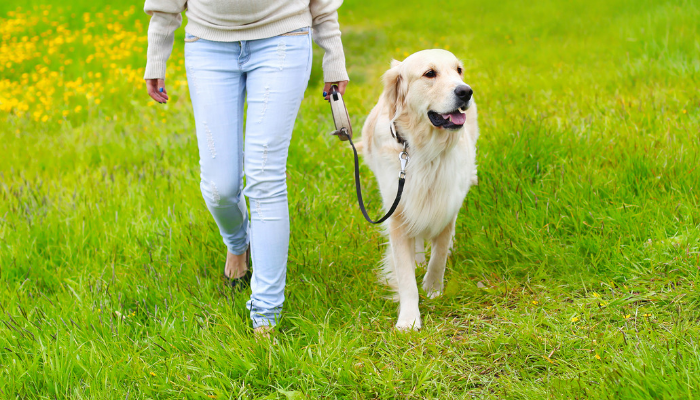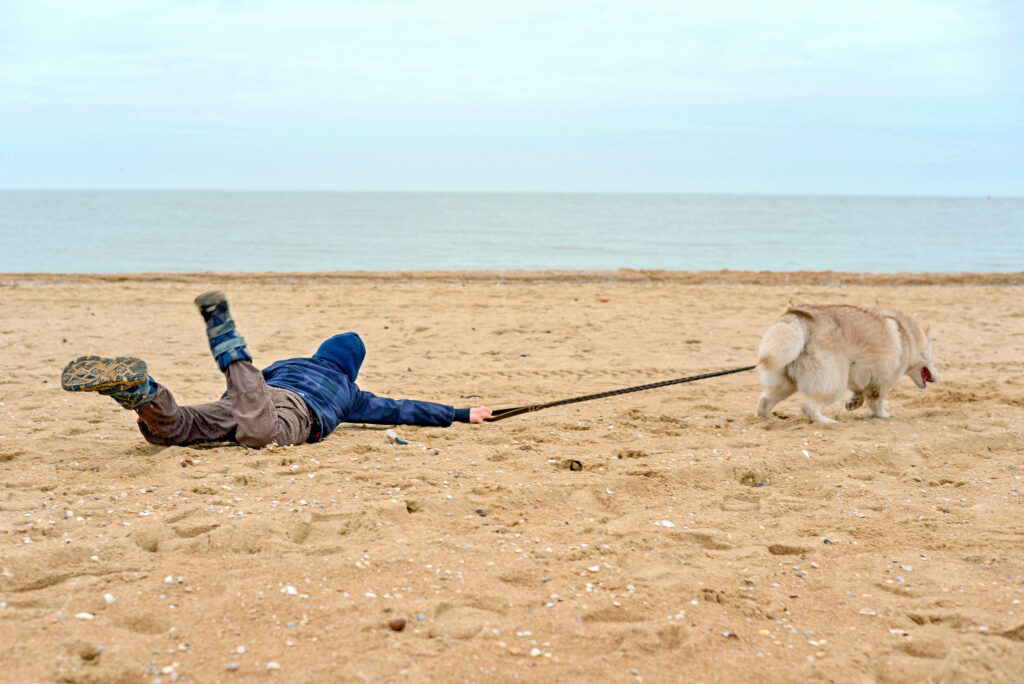Teaching your dog to walk nicely on a leash and Stop Your Dog from Pulling on the Leash is an essential skill for both your dog’s safety and your enjoyment during walks.
Teaching your dog to walk politely on a leash is an important skill for both their safety and your enjoyment during walks. Here are some steps you can take to Stop Your Dog from Pulling on the Leash:
- Use proper equipment: Start by using a sturdy and well-fitted harness instead of a collar. A harness gives you more control and reduces the strain on your dog’s neck, this makes Dog from Pulling on the Leash works perfectly.
- Start with basic obedience training: Teach your dog basic commands such as “sit,” “stay,” and “heel” in a controlled environment before practicing them on walks. This establishes a foundation for good leash manners.
- Use positive reinforcement: Reward your dog for good behavior using treats, praise, or play. When your dog walks calmly by your side without pulling, offer verbal praise and a treat. This positive reinforcement encourages them to continue the desired behavior.
- Stop and stand still: When your dog pulls on the leash, stop walking and stand still. Dogs quickly learn that pulling doesn’t get them where they want to go. Wait until your dog relaxes and the leash loosens, then continue walking. Repeat this process consistently.
- Change direction: If your dog pulls, abruptly change direction and start walking in the opposite direction. This catches their attention and teaches them to pay attention to your movements. Reward your dog when they adjust their behavior and walk alongside you.
- Use the “heel” command: Teach your dog the “heel” command, which means walking calmly by your side. Practice this command during walks by rewarding your dog for maintaining the proper position. Gradually increase the duration and distractions to solidify the behavior.
- Be consistent: Consistency is key to training success. Reinforce the desired behavior every time you walk your dog. Over time, your dog will learn that pulling doesn’t get them anywhere, while walking politely on the leash is rewarding.
- Gradually increase distractions: Start training in a quiet, low-distraction environment and gradually expose your dog to more distractions, such as other dogs or people. Increase the difficulty level gradually to help your dog generalize their leash manners to various situations.
Remember, training takes time and patience. Stay calm and consistent, and always use positive reinforcement techniques. If you’re having difficulties, consider seeking guidance from a professional dog trainer who can provide personalized assistance.
Why Dogs Pull on The Leash – Dog from Pulling on the Leash
Dogs commonly pull on the leash for various reasons, and understanding these reasons can help address the behavior. Here are some possible explanations for why Dog from Pulling on the Leash
- Excitement and enthusiasm: Dogs are naturally energetic animals, and they may get excited and pull when they encounter something interesting or stimulating, such as other dogs, people, or new environments. They want to explore and engage with their surroundings.
- Lack of leash training: Dogs need to be trained on how to walk on a leash properly. If they haven’t received proper training or if their training was inconsistent, they may not understand the concept of walking beside their owner without pulling.
- Natural instincts: Dogs have an instinctual tendency to explore their environment and follow scents which makes your Dog from Pulling on the Leash. When they catch a scent or see something intriguing, they may pull to investigate or follow their instincts.
- Reinforced behavior: If a dog has been inadvertently rewarded for pulling on the leash in the past, such as being allowed to move forward or reach something they desire, they may have learned that pulling gets them what they want, which reinforces the behavior.
- Lack of exercise or mental stimulation: Dogs that don’t receive sufficient physical exercise or mental stimulation may become restless and have excess energy, leading to pulling on the leash as a means of release or seeking stimulation.
- Fear or anxiety: Some Dog from Pulling on the Leash due to fear or anxiety. They may feel uncomfortable or threatened in certain situations, causing them to try to escape or distance themselves by pulling.
Addressing leash pulling requires consistent training and patience. Here are a few tips:

- Training: Teach your dog basic obedience commands, including “heel” or “walk nicely.” Use positive reinforcement techniques, such as treats or praise, to reward your dog when they walk calmly beside you without pulling.
- Leash management: Use a properly fitting harness or collar that gives you more control over your dog’s movements. Avoid using equipment that may cause pain or discomfort.
- Distraction and redirection: When your dog starts pulling, redirect their attention to you by using treats or toys. Engage them with commands or games that encourage focus and reinforce walking politely on the leash.
- Consistency: Be consistent with your training and expectations. Practice walking on a leash regularly and reward your dog for good behavior consistently. Avoid inadvertently rewarding pulling by allowing your dog to move forward when they pull.
- Seek professional help: If your dog’s leash pulling persists despite your efforts, consider seeking guidance from a professional dog trainer or behaviorist who can provide personalized advice and assistance.
Remember, each dog is unique, and the reasons for leash pulling can vary. By understanding your dog’s specific needs and using positive reinforcement training techniques, you can work towards better leash manners and enjoyable walks together.
Are there special collars to stop leash-pulling?
Yes, there are special collars designed to help reduce or stop leash-pulling in dogs. These collars work by providing a gentle and controlled method of discouraging pulling behavior. Here are a few types of collars commonly used for this purpose:
- Martingale Collar: Also known as a limited-slip collar, a Martingale collar is designed to tighten slightly when the dog pulls on the leash. It provides more control without choking the dog and helps prevent them from slipping out of the collar.
- Head Collar: A head collar, such as the Gentle Leader or Halti, is designed to fit over the dog’s snout and neck. It allows you to control the dog’s movements by controlling the direction of their head. When the dog pulls, the head collar gently redirects their attention back to you.
- No-Pull Harness: A no-pull harness is designed to discourage pulling by utilizing front attachment points for the leash. When the dog pulls, the harness redirects their forward momentum, making it more difficult for them to continue pulling. This type of harness reduces strain on the neck and provides better control.
READ ALSO:
- How to Teach Your Dog Agility – 5 Step-by-Step Tips to Practice Agility at Home with Your Dog
- Top 10 Dog Training Tips – How to Completely Train Your Dog
- Resource Guarding in Dogs – How to Address Resource Guarding in Dogs
It’s important to note that while these collars can be helpful tools for training and managing leash-pulling, they should always be used in conjunction with positive reinforcement training methods. Training, consistency, and patience are key to addressing leash-pulling behavior effectively and promoting loose leash walking. Consulting with a professional dog trainer or behaviorist can also provide valuable guidance tailored to your specific dog’s needs.
Best Dog Leashes
When it comes to selecting the best dog leash, there are several factors to consider, such as the size and behavior of your dog, your specific needs, and your personal preferences. Here are some popular types of dog leashes that are commonly recommended:
- Standard Leash: Also known as a flat leash, this is the most common type of dog leash. It is typically made of nylon or leather and comes in various lengths and widths. Standard leashes are suitable for most dogs and provide a reliable and straightforward way to control your dog during walks.
- Retractable Leash: Retractable leashes have a retractable cord that allows your dog to roam a bit farther while still maintaining control. They often feature a braking system that allows you to adjust the leash length. Retractable leashes can be convenient for giving your dog more freedom to explore, but they require responsible handling and may not be suitable for dogs with a tendency to pull or for use in crowded areas.
- Martingale Leash: Martingale leashes, also known as limited-slip leashes, consist of a standard leash attached to a martingale collar. These leashes are particularly useful for dogs with narrow heads, such as Greyhounds, as they prevent them from slipping out of the collar. They provide gentle control and prevent the dog from pulling too much.
- Hands-Free Leash: Hands-free leashes are designed to allow you to walk or run with your dog while keeping your hands free. They usually come in the form of belts or waistbands that attach to your waist or hips. Hands-free leashes are ideal for active individuals who want to engage in outdoor activities with their dogs.
- Training Leash: Training leashes, such as long lines or training leads, are typically longer than standard leashes, ranging from 15 to 30 feet or more. They are useful for teaching recall, practicing obedience commands, or allowing your dog to have more freedom while still maintaining control.
It’s essential to choose a leash that is appropriate for your dog’s size, strength, and behavior. Always prioritize safety, comfort, and durability when selecting a leash. Additionally, consider your specific needs and preferences to find the best leash that suits both you and your dog.
The article provided via this website should not be used to determine or treat a health problem or disease; it is not intended to offer any legal opinion or advice or a substitute for professional safety advice or professional care. Please consult your Vertinary Doctor or health care provider, attorney, or product manual for professional advice. Products and services reviewed are provided by third parties; we are not responsible in any way for them, nor do we guarantee their functionality, utility, safety, or reliability. Our content is for educational purposes only.
If you like, please share it. Sharing is usually caring.




